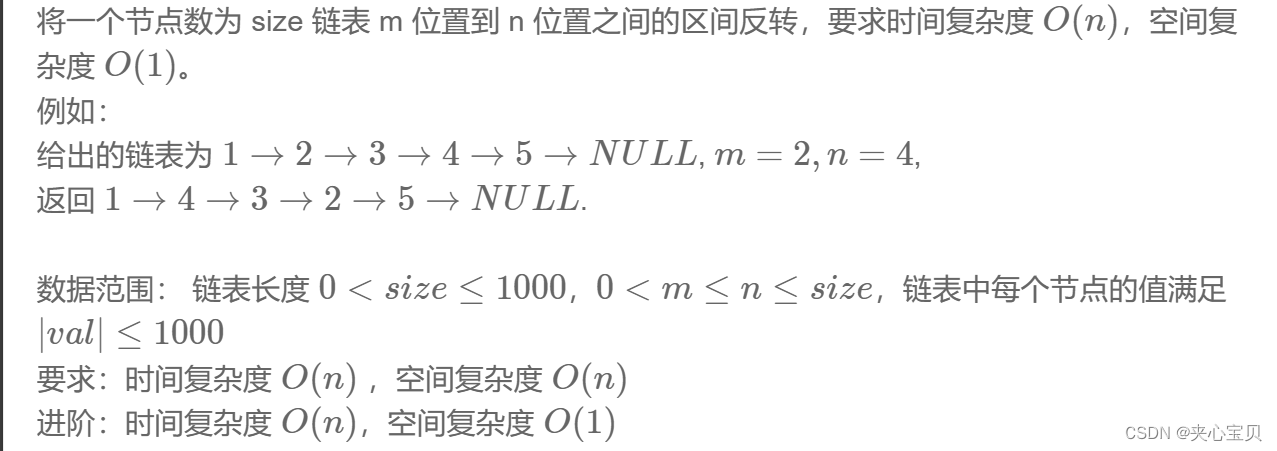链表OJ-----链表反转
? ? ? ? 1、链表局部反转
https://leetcode.cn/problems/reverse-linked-list-ii/
 ?????????
?????????
? ? ? ? 1、1初级要求:时间复杂度为O(n),空间复杂度为O(n)?
? ? ? ? 对于这个要求,我们可以想到,用一个数组,来记录反转区间中各结点的值,然后我们将数组中的值,倒着覆盖反转区间中各结点的值。?

? ? ? ? ?这个办法代码实现就比较简单了。
? ? ? ? 首先:知道反转区间链表的长度,方便开辟数组大小;然后遍历反转区间,将数放入到数组中;最后再遍历反转区间,将数组中的值,逆序放入反转区间中。
struct ListNode* reverseBetween(struct ListNode* head, int m, int n ) {
if (m == n) //不用翻转
return head;
if (head == NULL)
return head;
int dis1 = n - m + 1;//使用dis1,2来进行两次遍历
int dis2 = n - m + 1;
int* arr = (int*)malloc(sizeof(int) * dis1);
if (arr == NULL)
exit(-1);
struct ListNode* cur = head;
int tmp1 = m; //来找到第m个结点
//找
while (--tmp1) {
cur = cur->next;
}
struct ListNode* curtmp = cur;//再次记录第m个结点,便于后续覆盖值
//取值
int i = 0;
while (dis1--) {
arr[i++] = cur->val;
cur = cur->next;
}
//覆盖
while (dis2--) {//注意数组的下标
curtmp->val = arr[dis2];
curtmp = curtmp->next;
}
return head;
}? ? ? ? 1、2进阶要求:时间复杂度为O(n),空间复杂度为O(1)?
? ? ? ? 既然空间复杂度要求为O(1),那我们就不能开辟数组了,只能直接将反转区间的结点指向改变了。我们就需要用“头插法”来进行改变指向。?即:将反转区间中各个结点,当作头插进反转区间链表,那么结点指向就改变了。这里就借助两个指针prev和cur指针。
????????这里就需要考虑一个问题:头结点是否在反转区间内?如果在反转区间内,最后就不能返回头结点;如果不在,最后就返回头结点。
? ? ? ? 头结点不在反转区间内

? ? ? ? 头结点在反转区间内

struct ListNode* reverseBetween(struct ListNode* head, int m, int n ) {
if (m == n)
return head;
//头结点不在反转区间
if (m != 1) {
int step = n - m;//记录prev走多少步,走到第n个结点
struct ListNode* temp = head;//找第m-1个结点,记为temp
int M = m - 1;
while (--M) {
temp = temp->next;
}
struct ListNode* prev = temp->next;//第m个
struct ListNode* mtmp = prev;//记录第m个,方便最后改变指向
struct ListNode* cur = prev->next;//第m+1
//头插法
//prev走到第n个结束
while (step--) {
struct ListNode* next = cur->next;//记录cur的next
cur->next = prev;
prev = cur;
cur = next;
}
//此时prev在第n个,cur在第n+1个
temp->next = prev;//改变第m-1个结点的指向
mtmp->next = cur;//改变第m个结点的指向
return head;
}
//头结点在反转区间
else {
int step = n - m;//记录prev走多少步,走到第n个结点
struct ListNode* temp = head;//第m个
struct ListNode* prev = temp;//第m个
struct ListNode* cur = prev->next;//第m+1
//头插法
//prev走到第n个结束
while (step--) {
struct ListNode* next = cur->next;//记录cur的next
cur->next = prev;
prev = cur;
cur = next;
}
//此时prev在第n个,cur在第n+1个
temp->next = cur;
return prev;
}
return NULL;//否则链表为空
}? ? ? ? ?这里最重要的就是头插法,记录反转区间前后两个结点,以及改变指向。
? ? ? ? 2、链表整体反转
https://leetcode.cn/problems/reverse-linked-list/description/

? ? ? ? 有了前面局部反转的解决,那么整体反转就更简单了。就相当于一个长为x的链表,将区间[ 1,x]反转,就是全部反转了。那么这里就是包括头结点了,采用上面的方法二,可以说基本一模一样,最后头结点仍然指向最后一个结点的next(NULL),然后返回最后一个结点。
? ? ? ? 我们甚至可以在题中遍历链表得到长度,然后自己定义m = 1,n = x,然后再照搬上面的代码。不过那样不高级,我们还是自己手搓。
struct ListNode* reverseList(struct ListNode* head) {
if (head == NULL)//空链表
return NULL;
struct ListNode* tmp = head;
struct ListNode* prev = head;
struct ListNode* cur = prev->next;
//头插法
while (cur != NULL) // prev走到最后,即cur走到NULL
{
struct ListNode* next = cur->next; //记录cur的next
cur->next = prev;
prev = cur;
cur = next;
}
tmp->next = cur; //即tmp->next = NULL
return prev;
}? ? ? ? 这里最重要的就是头插法!!!
本文来自互联网用户投稿,该文观点仅代表作者本人,不代表本站立场。本站仅提供信息存储空间服务,不拥有所有权,不承担相关法律责任。 如若内容造成侵权/违法违规/事实不符,请联系我的编程经验分享网邮箱:chenni525@qq.com进行投诉反馈,一经查实,立即删除!
- Python教程
- 深入理解 MySQL 中的 HAVING 关键字和聚合函数
- Qt之QChar编码(1)
- MyBatis入门基础篇
- 用Python脚本实现FFmpeg批量转换
- Python调用C++接口传入并返回图像和其他参数(有框架代码)
- GC6129 双通道5V高细分步进电机pin-pin MS41929,应用于摇头机,X,Y控制,聚焦控制等产品中
- Oracle 日志路径查询介绍
- 京东短网址高可用回收策略分析
- excel统计分析——Lilliefors正态性检验
- 如何创业,创业的历程
- 解锁思维潜能,畅享XMind 2024 Mac/win中文版思维导图软件
- 【Vue】使用Axios请求下载后端返回的文件流,并能够提示后端报错信息
- LTE之帧结构
- redisson作为分布式锁的底层实现